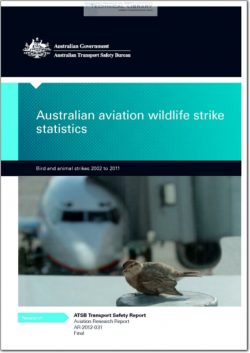ATSB-AR-2012-031
- Version
- 192 Downloads
- 3.51 MB File Size
- 1 File Count
- August 9, 2016 Create Date
- August 9, 2016 Last Updated
Australian Aviation Wildlife Strike Statistics

Each year, the Australian Transport Safety Bureau (ATSB) receives accident and
incident notifications from pilots, airlines, aerodrome personnel, air traffic control
and others involved in the aviation industry. The reporting of these aviation
accidents and incidents, collectively termed occurrences, assists the ATSB in
monitoring safety through its core function of independent investigation and the
analysis of data to identify emerging trends.
The Transport Safety Investigation Regulations 2003 provide a list of matters
reportable to the ATSB.1 One routine reportable matter has been a collision with an
animal, including a bird, for:
- all air transport operations (all bird and animal strikes), and
- aircraft operations other than air transport operations when the strike occurs on a
licensed aerodrome.
In addition to the above, all accidents2 are immediately reportable to the ATSB, and
all occurrences involving injury or difficulty controlling the aircraft (including from
a bird or animal strike) are reportable matters for all operation types.
A significant proportion of all occurrences reported to the ATSB involve aircraft
striking wildlife, especially birds. Wildlife strikes represent an ongoing challenge to
the aviation industry. Birds and other animals are hazards to aviation that will
always be present and so need to be managed, both in terms of reducing the
likelihood of a wildlife strike and reducing the consequences of strikes that occur.
For the purposes of this report, birdstrikes refer to strikes from all flying animals,
including bats, while animal strikes refer to strikes from all flightless animals,
including flightless birds.
This report provides aviation birdstrike and animal strike occurrence data for the
period 1 January 2002 to 31 December 2011. It should be noted that some data may
vary when compared with the previous Australian aviation wildlife strike statistics
report from 2002 to 2009 due to ongoing quality improvements in ATSB data.
The Australian aviation wildlife strike statistics report aims to give industry an
insight into the number, locations, and types of strikes in Australia, and describe
characteristics of the common birds and animals involved, and the consequences of
these strikes. This is the second edition of this report, which builds on the first
edition (released June 2010) through the addition of comparisons of strikes by
aircraft weight category, engine type, and analysis of rain fall, phase of flight and
time of day. This report will be updated biennially.
| File | Action |
|---|---|
| ATSB-AR-2012-031 Australian Aviation Wildlife Strike Statistics.pdf | Download |

Comment On This Post